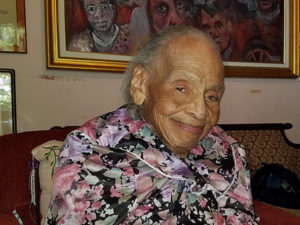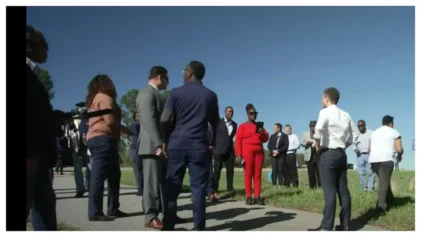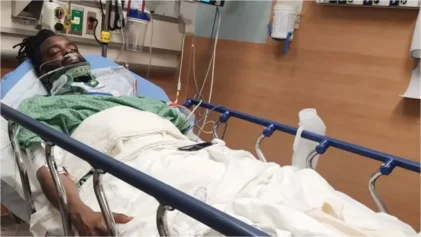
Olivia Hooker, 103, is believed to be the last surviving witness of the Tulsa Race Riot. (Photo by Nellie Gilles/Radio Diaries)
It’s been nearly 100 years since an angry white mob set fire to the predominately Black town of Greenwood, Okla., but survivor Olivia Hooker said the tragedy is something that will forever be etched in her memory.
Hooker was just 6 years old when a group of white men ran through her family’s backyard, torches in hand. She remembered her mother quickly hid her and her three siblings under the dining room table of their Tulsa, Okla., home, telling them not to make a sound as the men ransacked the place.
It was May 31, 1921 — the beginnings of what would become known as the Tulsa Race Riot of 1921.
“It was a horrifying thing for a little girl who’s only six years old,” Hooker told NPR’s Radio Diaries, “trying to remember to keep quiet, so they wouldn’t know we were there.”
Recalling that fateful day, Hooker, 103, said the group of men entered the home and began destroying everything in sight, including her father’s old record player and her sister Irene’s beloved piano. It wasn’t long before the men moved on to wreak havoc on the other homes and businesses in the thriving Black neighborhood, she said.
Before the events of that day, Tulsa’s Greenwood district was known for its thriving middle-class and successful Black-owned businesses. The Hooker family’s store, which sold quality brand-name clothes, was among the businesses that lined the neighborhood’s main strip, Greenwood Avenue.
Though Oklahoma still had stringent segregation laws, and the KKK was starting to make a comeback, Greenwood was sort of a haven for African-American families. Things started to unravel, however, after a young Black man named Dick Rowlands was accused of assaulting a white woman in an elevator. News of the alleged assault spread fast, further fueling racial tensions. Rowlands was arrested, and word spread that an angry white mob was on its way to find and lynch him.
Things soon reached a fever pitch, as the mobs were met by groups of armed men, many of whom severed in WWI, according to NPR. The day-long attack on Greenwood had begun. Less than 24 hours later, the white mobs had destroyed over 1,000 homes and businesses, setting fire to libraries, movie theaters, schools and even churches.
“Fires had been started by the white invaders soon after 1 o’clock and other fires were set from time to time,” The New York Times reported at the time. “By 8 o’clock practically the entire thirty blocks of homes in the negro quarters were up in flames, and few buildings escaped destruction. Negroes caught in their burning homes were in many instances shot down as they attempted to escape.”
There were several conflicting reports about the riots, but initial estimates put the death toll somewhere around 85, NPR reported. Other reports claimed as many as 300 people were killed in the violence. An estimated 9,000 people were left homeless after the riot, forcing many to move and rebuild their lives elsewhere.
“My father’s store was destroyed,” Hooker recalled. “There was nothing left but one big safe. It was so big they couldn’t carry it away, so they had to leave it — in the middle of the rubble.”
Hooker and her family were among those who packed up and left, eventually settling in Topeka, Kans.
As the years went on, the events of the Tulsa Race Riot began to fade from public memory. It wasn’t until Impact Magazine editor Don Ross published an article detailing the tragedy in 1971 — nearly 50 years after the fact.
“Our parents tried to tell us, don’t spend your time agonizing over the past,” Hooker said. “They encouraged us to look forward and think how we could make things better.”
Hooker did just that. She would go on to become the first African-American woman to join the U.S. Coast Guard and later helped form the Tulsa Race Riot Commission in 1997.


